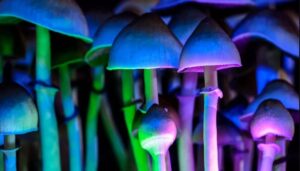Mushrooms containing psilocybin have been consumed for thousands of years. Magic mushrooms come in at least 202 distinct species. Because many species appear similar, distinguishing between them may be difficult. People could eat poisonous mushrooms thinking they are magical mushrooms, which is why it’s important to know the difference. You can try vision edibles mushroom reviews.
The ability of psychedelic drugs to potentiate profound altered states of consciousness is dose-dependent, according to research. Experienced changes in sense perceptions (such as visual illusions, synesthesia, and distorted proprioception), space-time orientation, and emotional processing are all used to characterize psychedelics’ dose-dependent capacity to potentiate profound altered states of consciousness. The phosphate group in the psilocybin molecule is enzymatically broken down to produce psilocin, an agonist at a variety of serotonin receptors including the 5-HT2A receptor, which plays important roles in modulating behavior, cognitive function, and motor function when ingested. You can find out more information about cannabis edible here.
Mushrooms contain chemicals called psilocybin and psilocin, which are known as the active components. Psilocybin and psilocin are psychoactive drugs that are controlled internationally by the United Nations Drug Control Conventions, as well as in Canada under the Controlled Drugs and Substances Act (CDSA). Sale, possession, and production of magic mushrooms, psilocybin, and psilocin are prohibited in Canada unless authorized by Health Canada (e.g., through the issuance of a licence or exemption, or under regulations). Psilocybin and psilocin are both controlled substances in Canada, like all narcotics. Magic mushrooms, like LSD, induce hallucinations and a altered state of mind. Users of magic mushrooms experience altered perceptions and hallucinations. Effects come on after 15 to 45 minutes and usually last for four to six hours.
Who Abuses Psilocybin?
Psilocybin mushrooms are frequently used at raves, dance clubs, and increasingly on college campuses, and they are most often abused by teenagers and young adults. Because psilocybin is not included in most data sources that measure drug usage, it’s difficult to assess how widespread its use is in the United States. According to the Monitoring the Future Survey, 9.2% of high school seniors in the United States have used other than LSD hallucinogens at least once in their lives, putting them into a category that includes psilocybin. In the past month, 2% of high school students used hallucinogenic drugs other than LSD.
What are The Risks?
Users of psilocybin are at risk of suffering negative physical and psychological repercussions. Nausea, vomiting, muscular weakness, drowsiness, and lack of coordination are all typical physical symptoms that appear 20 minutes after ingestion and last 6 hours. While there’s no evidence psilocybin dependence occurs among users, tolerance to the substance does develop when it is taken in large doses on a regular basis for a short time.
The psychological effects of psilocybin consumption include illusions and a loss of reality perception. Panic responses and psychosis may also emerge, especially if a person consumes a significant dose.
Those who consume psilocybin mushrooms run the danger of poisoning if one of the numerous varieties of poisonous mushrooms is mistaken for a psilocybin mushroom.
Consumption
Psilocybin-containing mushrooms are tiny and generally brown or tan in color. People frequently mistake psilocybin-containing mushrooms for various poisonous mushrooms in the wild.
Psilocybin is usually consumed as a tea or mixed with food to disguise its unpleasant flavor. Dried mushrooms are crushed into a powder and sold in capsule form by manufacturers. Some people eat these mushrooms with chocolate to hide the taste of them.
Extent of Use
According to the 2015 National Survey on Drug Use and Health, 8.5% of Americans have used psilocybin at some point in their lives.
Psilocybin has been used in religious or mystical contexts for millennia, most notably by pre-Columbian Mesoamerican cultures and continues today. Psilocybin is commonly consumed at dance clubs or by individuals seeking a spiritual enlightenment experience.
Doctors have investigated psilocybin in the context of headache therapy, depression, terminal cancer anxiety, and other types of anxiety in hospitals. Some researchers have raised concerns about its efficacy and safety as a therapeutic tool.
How is Psilocybin Used?
Psilocybin is a powerful hallucinogen found in certain types of mushrooms, which are usually taken orally. It’s also possible to make a tea from it. Typical dosages range from 10 to 50 milligrams (about 20 to 30 grams of fresh mushrooms or 1 to 2.5 grams of dried mushroom powder) and the effects generally take 1 to 2 hours to begin and last for approximately 6 hours. However, psilocybin concentrations differ considerably depending on the species, strength, and condition (fresh or dried) of the mushrooms.
Is Psilocybin Addictive?
Psilocybin is not considered an addictive drug. Although hallucinogen addiction is uncommon, poly-drug abusers (people who are addicted to several substances) frequently use them. However, psilocybin does create tolerance, thus users who take the drug on a regular basis must consume greater quantities to achieve the same effects. Given the unpredictability of the drug and dosage, this is quite risky. It has been discovered that psilocybin and other hallucinogens have cross-tolerance.
What is its legal status in the United States?
Psilocybin is a Schedule I drug under the Controlled Substances Act, which means it has a high potential for abuse, lacks currently accepted medical use in the United States, and lacks accepted safety for use under medical supervision.
